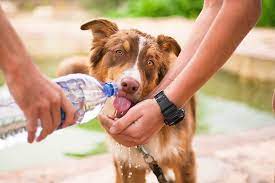As responsible pet owners, it is important for us to ensure that our furry friends are properly hydrated at all times.
Water is essential for maintaining their overall health and well-being. But have you ever wondered how long a dog can go without water?
The importance of water for dogs
Water plays a crucial role in the health and well-being of our beloved dogs. Just like humans, dogs relies on water for numerous physiological functions. It helps regulate their body temperature, aids digestion, lubricates joints, and flushes out toxins from their system.
Providing your dog with a consistent supply of clean, fresh water is therefore vital. The amount of water they need depends on several factors, including their size, activity level, and the climate they live in. As a pet owner, it’s essential to monitor your dog’s water intake and ensure that their dish is always filled.
Factors
While it’s clear that dogs need an adequate supply of water to stay healthy, the amount they actually require can vary based on a few important factors. Understanding these factors can help you ensure that your furry friend receives the right amount of hydration.
1. Size:
Generally, larger dogs will require more water than smaller breeds. This is because they have a higher body mass and thus need more water to maintain proper bodily functions.
2. Activity Level:
Dogs that are highly active, such as those that participate in rigorous exercise or work-related activities, will need more water to replenish what they lose through sweating and panting.
3. Climate:
Dogs in hot or humid climates will naturally need more water to cool down and prevent dehydration. Similarly, dogs in cold climates may also require additional water to compensate for the dryness of indoor heating systems.
How long can a dog go without water?
It is crucial for dog owners to understand how long their furry companions can go without water. While it is recommended that dogs have access to fresh water at all times, certain circumstances may prevent them from having water readily available.
Dog can survive for about three to five days without water. However, this should never be the norm or an intentional practice. Dehydration can have severe consequences on a dog’s health, leading to organ failure, urinary tract issues, and even death.
It is important to note that the duration a dog can go without water depends on various factors such as their overall health, activity level, and the climate they are in.
As responsible pet owners, it is our duty to prioritize our dog’s hydration needs and ensure they have access to water throughout the day. This may involve providing fresh, clean water in multiple locations, especially during hot weather or periods of increased physical activity.
Signs of dehydration in dogs
As responsible pet owners, it is essential to be aware of the signs of dehydration in our dogs. Recognizing these signs can help us take prompt action to ensure our furry companions receive the hydration they need.
1. Excessive Panting:
Dogs regulate their body temperature through panting, but excessive panting can be a sign that they are overheating and in need of water.
2. Dry Gums and Tongue:
Dehydrated dogs often have dry, sticky gums and a dry tongue. In healthy dogs, the gums should be moist and pink.
3. Reduced Urination:
Monitoring your dog’s urination is crucial. If you notice a significant decrease in the frequency or volume of urine, it may indicate dehydration.
4. Lethargy and Weakness:
Dehydrated dogs may appear tired, lethargic, and have reduced energy levels. They may also have difficulty standing or walking.
5. Sunken Eyes and Skin Elasticity:
Dehydration can cause a dog’s eyes to appear sunken, and their skin to lose elasticity. To test their skin elasticity, gently pinch and lift the skin on the back of their neck. If it takes longer to spring back into place, it may indicate dehydration.
Preventing dehydration in dogs
Preventing dehydration in dogs begins with providing them with a constant supply of clean, fresh water. Make sure your dog’s water bowl is always filled and easily accessible, especially during hot weather or periods of increased activity.
It’s also important to be mindful of your dog’s exercise routine. During rigorous activities, provide frequent water breaks to prevent them from becoming dehydrated.
Another way to prevent dehydration is by incorporating wet food into your dog’s diet. Wet food contains higher water content, helping to keep your dog hydrated. You can also consider feeding your dog fruits and vegetables with high water content.
Conclusion
It is vital to prioritize your dog’s hydration to ensure their well-being. By providing a constant supply of clean water and frequent water breaks during exercise, you can prevent dehydration.
Incorporating wet food and water-rich fruits and vegetables into their diet can also help maintain their hydration levels. Dehydration can lead to serious health issues in dogs, so it is important to be proactive and take preventative measures.



